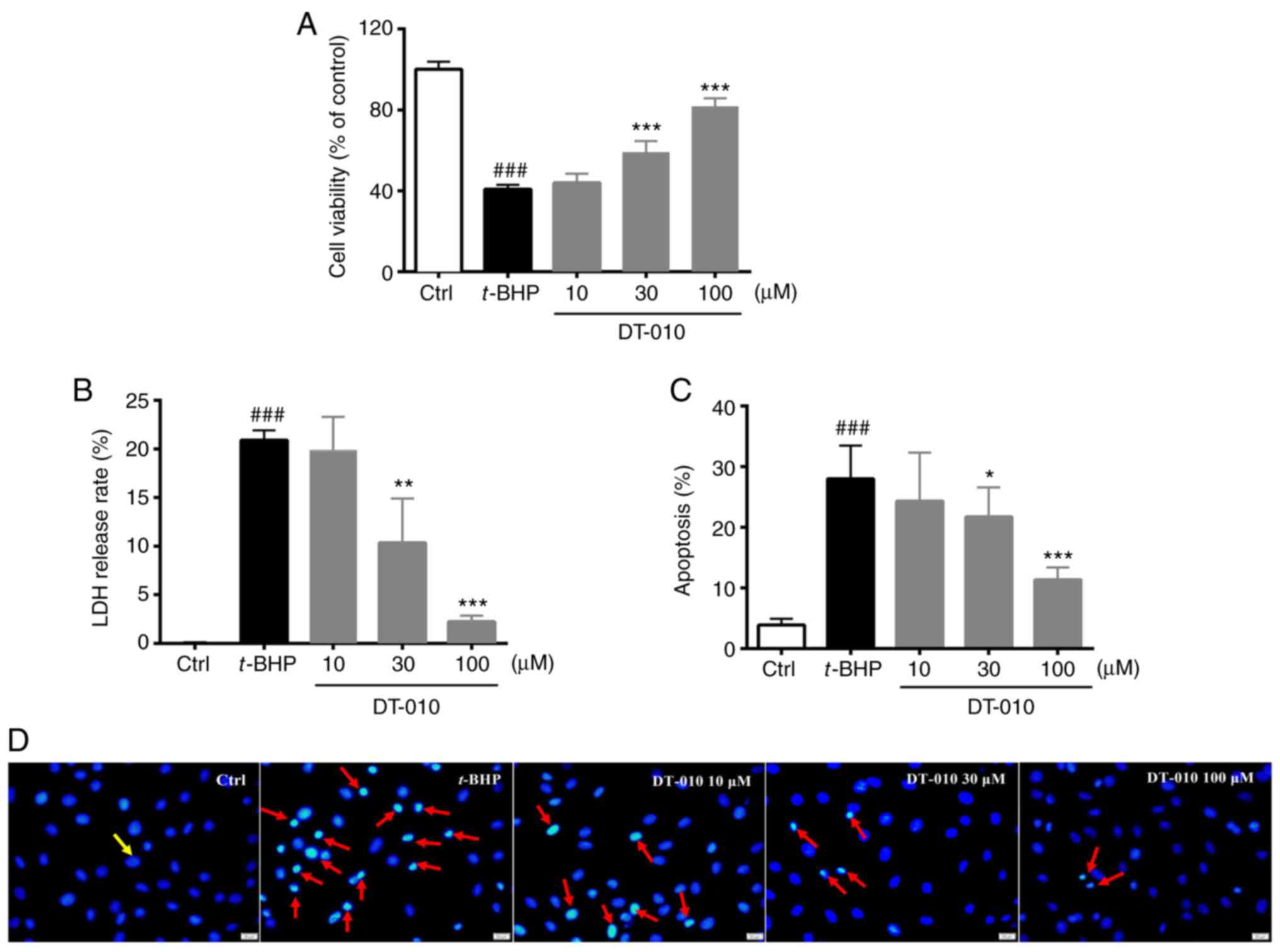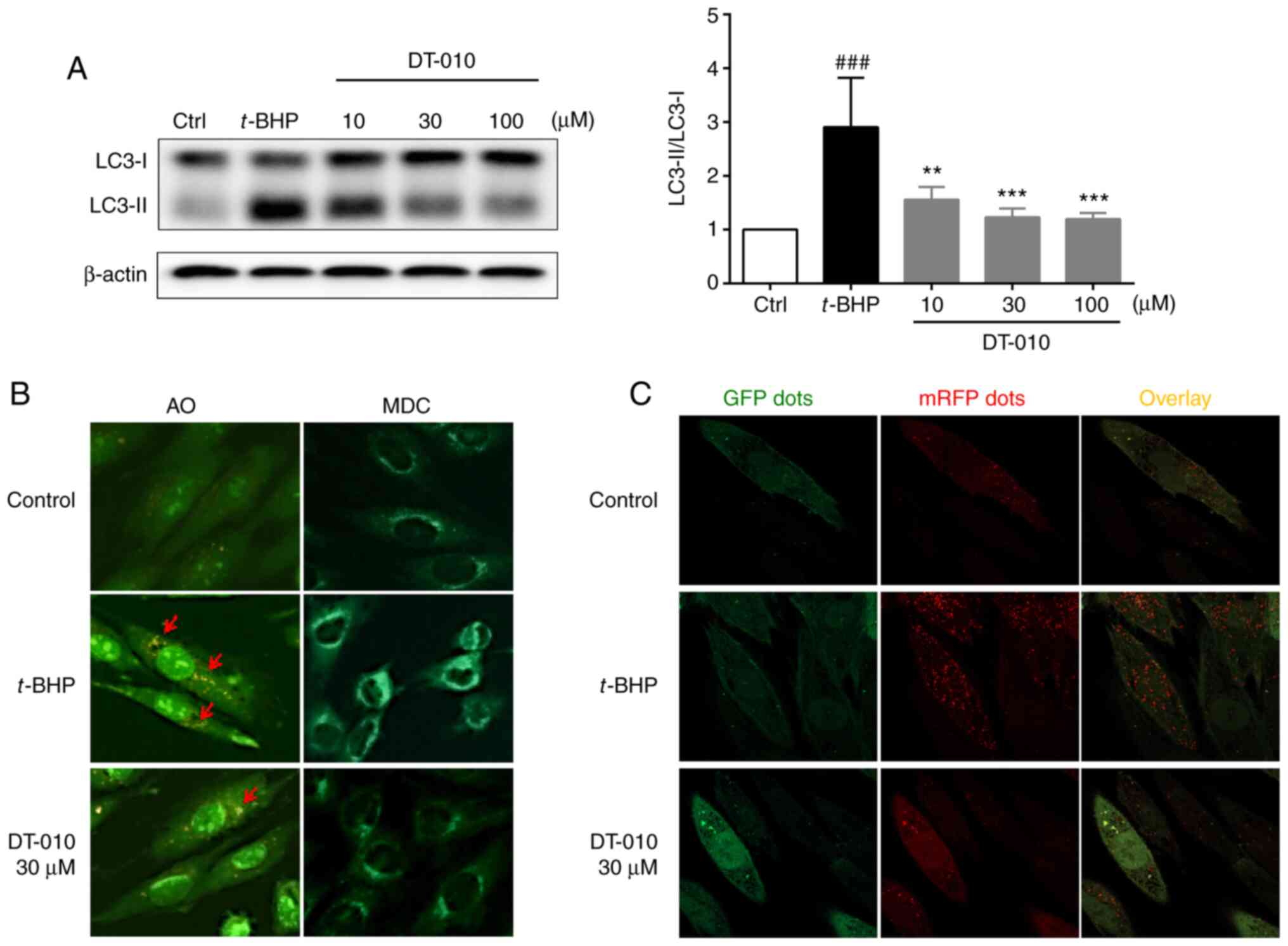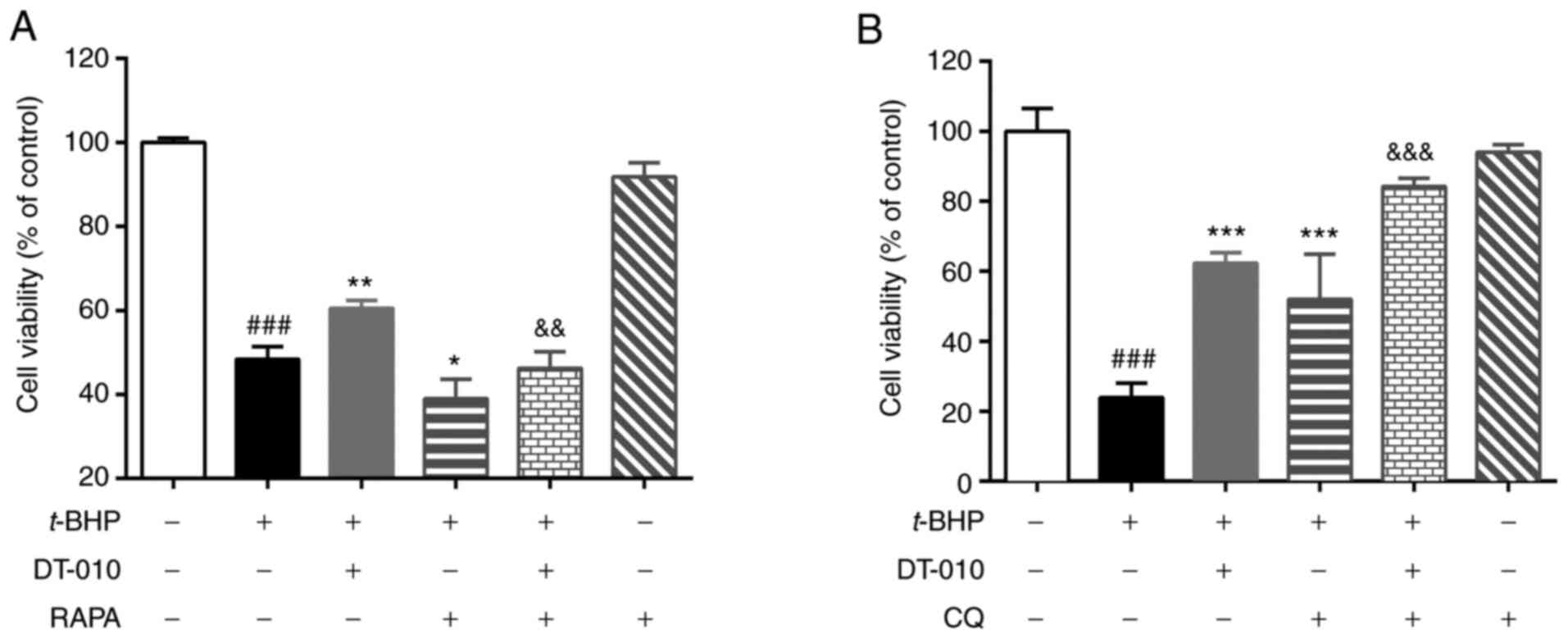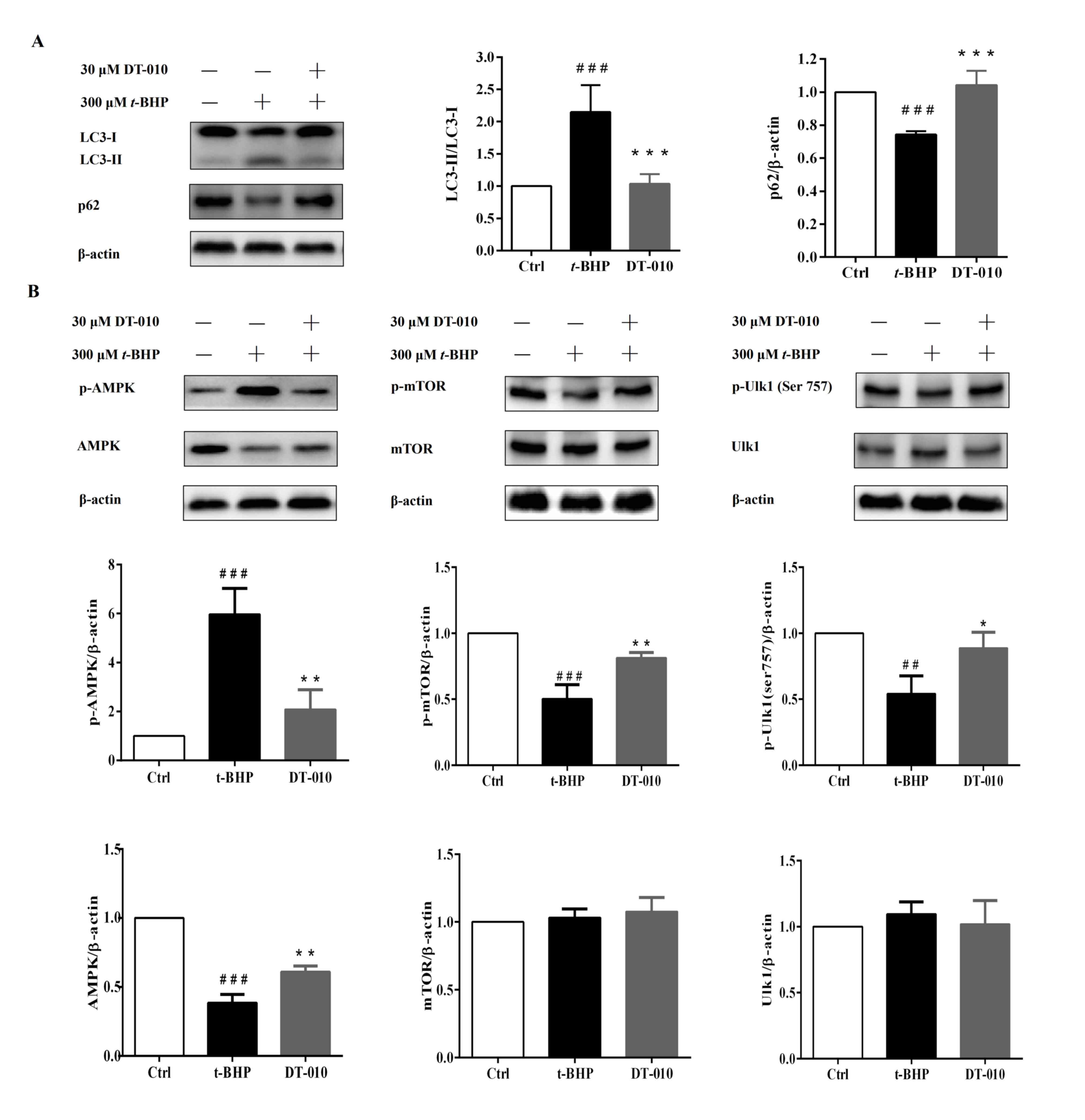|
1
|
Mendis S, Puska P and Norrving B: World
Health Organization, World Heart Federation: Global atlas on
cardiovascular disease prevention and control. Mendis S and Puska P
(eds). WHO, Geneva, pp1-155, 2011.
|
|
2
|
Kalogeris T, Baines CP, Krenz M and
Korthuis RJ: Ischemia/reperfusion. Compr Physiol. 7:113–170.
2016.PubMed/NCBI View Article : Google Scholar
|
|
3
|
Li T, Su Y, Yu X, Mouniir DSA, Masau JF,
Wei X and Yang J: Trop2 guarantees cardioprotective effects of
cortical bone-derived stem cells on myocardial ischemia/reperfusion
injury. Cell Transplant. 27:1256–1268. 2018.PubMed/NCBI View Article : Google Scholar
|
|
4
|
Matsui Y, Takagi H, Qu X, Abdellatif M,
Sakoda H, Asano T, Levine B and Sadoshima J: Distinct roles of
autophagy in the heart during ischemia and reperfusion: Roles of
AMP-activated protein kinase and Beclin 1 in mediating autophagy.
Circ Res. 100:914–922. 2007.PubMed/NCBI View Article : Google Scholar
|
|
5
|
Hamacher-Brady A, Brady NR, Logue S, Sayen
MR, Jinno M, Kirshenbaum L, Gottlieb RA and Gustafsson AB: Response
to myocardial ischemia/reperfusion injury involves Bnip3 and
autophagy. Cell Death Differ. 14:146–157. 2007.PubMed/NCBI View Article : Google Scholar
|
|
6
|
Valentim L, Laurence KM, Townsend PA,
Carroll CJ, Soond S, Scarabelli TM, Knight RA, Latchman DS and
Stephanou A: Urocortin inhibits Beclin1-mediated autophagic cell
death in cardiac myocytes exposed to ischaemia/reperfusion injury.
J Mol Cell Cardiol. 40:846–852. 2006.PubMed/NCBI View Article : Google Scholar
|
|
7
|
Yan L, Sadoshima J, Vatner DE and Vatner
SF: Autophagy: A novel protective mechanism in chronic ischemia.
Cell Cycle. 5:1175–1177. 2006.PubMed/NCBI View Article : Google Scholar
|
|
8
|
Yan L, Vatner DE, Kim SJ, Ge H, Masurekar
M, Massover WH, Yang G, Matsui Y, Sadoshima J and Vatner SF:
Autophagy in chronically ischemic myocardium. Proc Natl Acad Sci
USA. 102:13807–13812. 2005.PubMed/NCBI View Article : Google Scholar
|
|
9
|
Li X, Huang Q, Wang M, Yan X, Song X, Ma
R, Jiang R, Zhao D and Sun L: Compound K inhibits
autophagy-mediated apoptosis through activation of the PI3K-Akt
signaling pathway thus protecting against ischemia/reperfusion
injury. Cell Physiol Biochem. 47:2589–2601. 2018.PubMed/NCBI View Article : Google Scholar
|
|
10
|
Przyklenk K, Dong Y, Undyala VV and
Whittaker P: Autophagy as a therapeutic target for
ischaemia/reperfusion injury? Concepts, controversies, and
challenges. Cardiovasc Res. 94:197–205. 2012.PubMed/NCBI View Article : Google Scholar
|
|
11
|
Araujo TF, Cordeiro AV, Vasconcelos DAA,
Vitzel KF and Silva VRR: The role of cathepsin B in autophagy
during obesity: A systematic review. Life Sci. 209:274–281.
2018.PubMed/NCBI View Article : Google Scholar
|
|
12
|
Ravikumar B, Sarkar S, Davies JE, Futter
M, Garcia-Arencibia M, Green-Thompson ZW, Jimenez-Sanchez M,
Korolchuk VI, Lichtenberg M, Luo S, et al: Regulation of mammalian
autophagy in physiology and pathophysiology. Physiol Rev.
90:1383–1435. 2010.PubMed/NCBI View Article : Google Scholar
|
|
13
|
Zhao W, Feng H, Sun W, Liu K, Lu JJ and
Chen X: Tert-butyl hydroperoxide (t-BHP) induced apoptosis and
necroptosis in endothelial cells: Roles of NOX4 and mitochondrion.
Redox Biol. 11:524–534. 2017.PubMed/NCBI View Article : Google Scholar
|
|
14
|
Zhao Y, Zhang F, Zhao X, Yuan W, Zhang J
and Wang Y: Shenmai injection protects mitochondria from oxidative
injury in myocardial cells and its mechanism. Zhejiang Da Xue Xue
Bao Yi Xue Ban. 47:507–513. 2018.PubMed/NCBI(In Chinese).
|
|
15
|
Silva JP, Sardao VA, Coutinho OP and
Olveira PJ: Nitrogen compounds prevent h9c2 myoblast oxidative
stress-induced mitochondrial dysfunction and cell death. Cardiovasc
Toxicol. 10:51–65. 2010.PubMed/NCBI View Article : Google Scholar
|
|
16
|
Lu D, Zhu LH, Shu XM, Zhang CJ, Zhao JY,
Qi RB, Wang HD and Lu DX: Ginsenoside Rg1 relieves tert-Butyl
hydroperoxide-induced cell impairment in mouse microglial BV2
cells. J Asian Nat Prod Res. 17:930–945. 2015.PubMed/NCBI View Article : Google Scholar
|
|
17
|
Li Z, Jiang T, Lu Q, Xu K, He J, Xie L,
Chen Z, Zheng Z, Ye L, Xu k, et al: Berberine attenuated the
cytotoxicity induced by t-BHP via inhibiting oxidative stress and
mitochondria dysfunction in PC-12 cells. Cell Mol Neurobiol.
40:587–602. 2020.PubMed/NCBI View Article : Google Scholar
|
|
18
|
Fan G, Yu J, Asare PF, Wang L, Zhang H,
Zhang B, Zhu Y and Gao X: Danshensu alleviates cardiac
ischaemia/reperfusion injury by inhibiting autophagy and apoptosis
via activation of mTOR signalling. J Cell Mol Med. 20:1908–1919.
2016.PubMed/NCBI View Article : Google Scholar
|
|
19
|
Zhigang P, Huishan P, Guangchun J and
Xiangshan L: An experimental study of ligustrazine on ischemic
myocardial protection and scavenging oxygen free radicals. Chin
Wild Plant Resou. 5(21)2000.
|
|
20
|
Zhang X, Hu H, Luo J, Deng H, Yu P, Zhang
Z, Zhang G, Shan L and Wang Y: A novel
danshensu-tetramethylpyrazine conjugate DT-010 provides
cardioprotection through the PGC-1α/Nrf2/HO-1 pathway. Biol Pharm
Bull. 40:1490–1498. 2017.PubMed/NCBI View Article : Google Scholar
|
|
21
|
Tang F, Zhou X, Wang L, Shan L, Li C, Zhou
H, Lee SM and Hoi MP: A novel compound DT-010 protects against
doxorubicin-induced cardiotoxicity in zebrafish and H9c2 cells by
inhibiting reactive oxygen species-mediated apoptotic and
autophagic pathways. Eur J Pharmacol. 820:86–96. 2018.PubMed/NCBI View Article : Google Scholar
|
|
22
|
Wang Y, Zhang X, Xu C, Zhang G, Zhang Z,
Yu P, Shan L, Sun Y and Wang Y: Synthesis and biological evaluation
of danshensu and tetramethylpyrazine conjugates as cardioprotective
agents. Chem Pharm Bull (Tokyo). 65:381–388. 2017.PubMed/NCBI View Article : Google Scholar
|
|
23
|
Shi X, Zhu H, Zhang Y, Zhou M, Tang D and
Zhang H: XuefuZhuyu decoction protected cardiomyocytes against
hypoxia/reoxygenation injury by inhibiting autophagy. BMC
Complement Altern Med. 17(325)2017.PubMed/NCBI View Article : Google Scholar
|
|
24
|
Zuo Y, Zhang J, Cheng X, Li J, Yang Z, Liu
X, Gu E and Zhang Y: Enhanced autophagic flux contributes to
cardioprotection of remifentanil postconditioning after
hypoxia/reoxygenation injury in H9c2 cardiomyocytes. Biochem
Biophys Res Commun. 514:953–959. 2019.PubMed/NCBI View Article : Google Scholar
|
|
25
|
Zhao M, Sun L, Yu XJ, Miao Y, Liu JJ, Wang
H, Ren J and Zang WJ: Acetylcholine mediates AMPK-dependent
autophagic cytoprotection in H9c2 cells during
hypoxia/reoxygenation injury. Cell Physiol Biochem. 32:601–613.
2013.PubMed/NCBI View Article : Google Scholar
|
|
26
|
Mizushima N: Methods for monitoring
autophagy. Int J Biochem Cell Biol. 36:2491–2502. 2004.PubMed/NCBI View Article : Google Scholar
|
|
27
|
Chang CH, Lee CY, Lu CC, Tsai FJ, Hsu YM,
Tsao JW, Juan YN, Chiu HY, Yang JS and Wang CC: Resveratrol-induced
autophagy and apoptosis in cisplatin-resistant human oral cancer
CAR cells: A key role of AMPK and Akt/mTOR signaling. Int J Oncol.
50:873–882. 2017.PubMed/NCBI View Article : Google Scholar
|
|
28
|
Liu F, Gao S, Yang Y, Zhao X, Fan Y, Ma W,
Yang D, Yang A and Yu Y: Curcumin induced autophagy anticancer
effects on human lung adenocarcinoma cell line A549. Oncol Lett.
14:2775–2782. 2017.PubMed/NCBI View Article : Google Scholar
|
|
29
|
Alers S, Löffler AS, Wesselborg S and
Stork B: Role of AMPK-mTOR-Ulk1/2 in the regulation of autophagy:
Cross talk, shortcuts, and feedbacks. Mol Cell Biol. 32:2–11.
2012.PubMed/NCBI View Article : Google Scholar
|
|
30
|
Ansari MY, Ahmad N and Haqqi TM: Butein
activates autophagy through AMPK/TSC2/ULK1/mTOR pathway to inhibit
IL-6 expression in IL-1β stimulated human chondrocytes. Cell
Physiol Biochem. 49:932–946. 2018.PubMed/NCBI View Article : Google Scholar
|
|
31
|
Zhang Y and Miao JM: Ginkgolide K promotes
astrocyte proliferation and migration after oxygen-glucose
deprivation via inducing protective autophagy through the
AMPK/mTOR/ULK1 signaling pathway. Eur J Pharmacol. 832:96–103.
2018.PubMed/NCBI View Article : Google Scholar
|
|
32
|
Cai ZY, Yang B, Shi YX, Zhang WL, Liu F,
Zhao W and Yang MW: High glucose downregulates the effects of
autophagy on osteoclastogenesis via the AMPK/mTOR/ULK1 pathway.
Biochem Biophys Res Commun. 503:428–435. 2018.PubMed/NCBI View Article : Google Scholar
|
|
33
|
Cui G, Shan L, Hung M, Lei S, Choi I,
Zhang Z, Yu P, Hoi P, Wang Y and Lee SM: A novel Danshensu
derivative confers cardioprotection via PI3K/Akt and Nrf2 pathways.
Int J Cardiol. 168:1349–1359. 2013.PubMed/NCBI View Article : Google Scholar
|
|
34
|
Cui Q, Chen Y, Zhang M, Shan L, Sun Y, Yu
P, Zhang G, Wang D, Zhao Z, Xu Q, et al: Design, synthesis, and
preliminary cardioprotective effect evaluation of danshensu
derivatives. Chem Biol Drug Des. 84:282–291. 2014.PubMed/NCBI View Article : Google Scholar
|
|
35
|
Xu CJ, Deng HX, Chen HY, Cui QB, Shan LC,
Yu P, Sun YW and Wang YQ: Design, synthesis and biological
evaluations of novel conjugates of Danshensu, tetramethylpyrazine
and hydrogen sulfide donors as cardioprotective agents. Asian J
Chem. 28:2555–2561. 2016.
|
|
36
|
Lemasters JJ, Nieminen AL, Qian T, Trost
LC, Elmore SP, Nishimura Y, Crowe RA, Cascio WE, Bradham CA,
Brenner DA and Herman B: The mitochondrial permeability transition
in cell death: A common mechanism in necrosis, apoptosis and
autophagy. Biochim Biophys Acta. 1366:177–196. 1998.PubMed/NCBI View Article : Google Scholar
|
|
37
|
Huang KY, Wang JN, Zhou YY, Wu SZ, Tao LY,
Peng YP, Que JQ, Xue YJ and Ji KT: Antithrombin III alleviates
myocardial ischemia/reperfusion injury by inhibiting excessive
autophagy in a phosphoinositide 3-kinase/Akt-dependent manner.
Front Pharmacol. 10(516)2019.PubMed/NCBI View Article : Google Scholar
|
|
38
|
Zhang YW, Shi J, Li YJ and Wei L:
Cardiomyocyte death in doxorubicin-induced cardiotoxicity. Arch
Immunol Ther Exp (Warsz). 57:435–445. 2009.PubMed/NCBI View Article : Google Scholar
|
|
39
|
Wang D, Yu W, Liu Y, Zhong G, Zhao Z, Yan
X and Liu Q: Roles of autophagy in ischemic heart diseases and the
modulatory effects of Chinese herbal medicine. Am J Chin Med.
45:1401–1419. 2017.PubMed/NCBI View Article : Google Scholar
|
|
40
|
Hao M, Zhu S, Hu L, Zhu H, Wu X and Li Q:
Myocardial ischemic postconditioning promotes autophagy against
ischemia reperfusion injury via the activation of the
nNOS/AMPK/mTOR pathway. Int J Mol Sci. 18(614)2017.PubMed/NCBI View Article : Google Scholar
|
|
41
|
Gao C, Wang R, Li B, Guo Y, Yin T, Xia Y,
Zhang F, Lian K, Liu Y, Wang H, et al: TXNIP/Redd1 signalling and
excessive autophagy: A novel mechanism of myocardial
ischaemia/reperfusion injury in mice. Cardiovasc Res. 116:645–657.
2020.PubMed/NCBI View Article : Google Scholar
|
|
42
|
Li X, Hu X, Wang J, Xu W, Yi C, Ma R and
Jiang H: Inhibition of autophagy via activation of PI3K/Akt/mTOR
pathway contributes to the protection of hesperidin against
myocardial ischemia/reperfusion injury. Int J Mol Med.
42:1917–1924. 2018.PubMed/NCBI View Article : Google Scholar
|
|
43
|
Yang SS, Liu YB, Yu JB, Fan Y, Tang SY,
Duan WT, Wang Z, Gan RT and Yu B: Rapamycin protects heart from
ischemia/reperfusion injury independent of autophagy by activating
PI3 kinase-Akt pathway and mitochondria K(ATP) channel. Pharmazie.
65:760–765. 2010.PubMed/NCBI
|
|
44
|
Xu Q, Li X, Lu Y, Shen L, Zhang J, Cao S,
Huang X, Bin J and Liao Y: Pharmacological modulation of autophagy
to protect cardiomyocytes according to the time windows of
ischaemia/reperfusion. Br J Pharmacol. 172:3072–3085.
2015.PubMed/NCBI View Article : Google Scholar
|
|
45
|
Qu X, Chen X, Shi Q, Wang X, Wang D and
Yang L: Resveratrol alleviates ischemia/reperfusion injury of
diabetic myocardium via inducing autophagy. Exp Ther Med.
18:2719–2725. 2019.PubMed/NCBI View Article : Google Scholar
|
|
46
|
Yang J, He J, Ismail M, Tweeten S, Zeng F,
Gao L, Ballinger S, Young M, Prabhu SD, Rowe GC, et al: HDAC
inhibition induces autophagy and mitochondrial biogenesis to
maintain mitochondrial homeostasis during cardiac
ischemia/reperfusion injury. J Mol Cell Cardiol. 130:36–48.
2019.PubMed/NCBI View Article : Google Scholar
|
|
47
|
Wang F, Pulinilkunnil T, Flibotte S,
Nislow C, Vlodavsky I, Hussein B and Rodrigues B: Heparanase
protects the heart against chemical or ischemia/reperfusion injury.
J Mol Cell Cardiol. 131:29–40. 2019.PubMed/NCBI View Article : Google Scholar
|
|
48
|
Wang G, Dai G, Song J, Zhu M, Liu Y, Hou
X, Ke Z, Zhou Y, Qiu H, Wang F, et al: Lactone component from
ligusticum chuanxiong alleviates myocardial ischemia injury through
inhibiting autophagy. Front Pharmacol. 9(301)2018.PubMed/NCBI View Article : Google Scholar
|
|
49
|
Wu S, Chang G, Gao L, Jiang D, Wang L, Li
G, Luo X, Qin S, Guo X and Zhang D: Trimetazidine protects against
myocardial ischemia/reperfusion injury by inhibiting excessive
autophagy. J Mol Med (Berl). 96:791–806. 2018.PubMed/NCBI View Article : Google Scholar
|
|
50
|
Xi X, Zou C, Ye Z, Huang Y, Chen T and Hu
H: Pioglitazone protects tubular cells against
hypoxia/reoxygenation injury through enhancing autophagy via
AMPK-mTOR signaling pathway. Eur J Pharmacol.
863(172695)2019.PubMed/NCBI View Article : Google Scholar
|
|
51
|
Yang Y, Li N, Chen T, Zhang C, Liu L, Qi Y
and Bu P: Trimetazidine ameliorates sunitinib-induced
cardiotoxicity in mice via the AMPK/mTOR/autophagy pathway. Pharm
Biol. 57:625–631. 2019.PubMed/NCBI View Article : Google Scholar
|
|
52
|
Dong Y, Chen H, Gao J, Liu Y, Li J and
Wang J: Molecular machinery and interplay of apoptosis and
autophagy in coronary heart disease. J Mol Cell Cardiol. 136:27–41.
2019.PubMed/NCBI View Article : Google Scholar
|
|
53
|
Yan J, Yan JY, Wang YX, Ling YN, Song XD,
Wang SY, Liu HQ, Liu QC, Zhang Y, Yang PZ, et al:
Spermidine-enhanced autophagic flux improves cardiac dysfunction
following myocardial infarction by targeting the AMPK/mTOR
signalling pathway. Br J Pharmacol. 176:3126–3142. 2019.PubMed/NCBI View Article : Google Scholar
|
|
54
|
Wang L, Yuan D, Zheng J, Wu X, Wang J, Liu
X, He Y, Zhang C, Liu C, Wang T and Zhou Z: Chikusetsu saponin IVa
attenuates isoprenaline-induced myocardial fibrosis in mice through
activation autophagy mediated by AMPK/mTOR/ULK1 signaling.
Phytomedicine. 58(152764)2019.PubMed/NCBI View Article : Google Scholar
|
|
55
|
Rabinovitc RC, Samborska B, Faubert B, Ma
EH, Gravel SP, Andrzejewski S, Raissi TC, Pause A, St-Pierre J and
Jones RG: AMPK maintains cellular metabolic homeostasis through
regulation of mitochondrial reactive oxygen species. Cell Rep.
21:1–9. 2017.PubMed/NCBI View Article : Google Scholar
|
|
56
|
Zhang T, Liu J, Tong Q and Lin L: SIRT3
acts as a positive autophagy regulator to promote lipid
mobilization in adipocytes via activating AMPK. Int J Mol Sci.
21(372)2020.PubMed/NCBI View Article : Google Scholar
|
|
57
|
Kim J, Kundu M, Viollet B and Guan KL:
AMPK and mTOR regulate autophagy through direct phosphorylation of
Ulk1. Nat Cell Biol. 13:132–141. 2011.PubMed/NCBI View Article : Google Scholar
|
|
58
|
Ren PH, Zhang ZM, Wang P, Zhu HP and Li
ZQ: Yangxinkang tablet protects against cardiac dysfunction and
remodelling after myocardial infarction in rats through inhibition
of AMPK/mTOR-mediated autophagy. Pharm Biol. 58:321–327.
2020.PubMed/NCBI View Article : Google Scholar
|
|
59
|
Jin Q, Jhun BS, Lee SH, Lee J, Pi Y, Cho
YH, Baik HH and Kang I: Differential regulation of
phosphatidylinositol 3-kinase/Akt, mitogen-activated protein
kinase, and AMP-activated protein kinase pathways during
menadione-induced oxidative stress in the kidney of young and old
rats. Biochem Biophys Res Commun. 315:555–561. 2004.PubMed/NCBI View Article : Google Scholar
|














